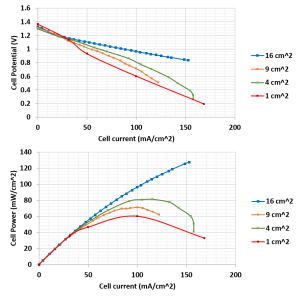Last year we used 6 Zn-Air batteries with a surface area of 25 cm^2 each. We knew this was more than was required, however, due to time constraints and lack of testing equipment, we stuck to it. Earlier this year our undergrad and graduate advisors helped us build and test batteries (using some easy to use equipment from the electrochem lab!) of different sizes to determine the battery surface area we actually need to power our car. We made 4 test cells: 1×1, 2×2, 3×3 and 4×4 (cm by cm). Our current motor is a 12V motor with the ability to draw >1 A (so we want at least 12W on the car). From the polarization curves it is clear that mass transfer impacts all the cells besides the 4×4 at currents >35 mA/cm^2. We also see that 6 of the 4×4 cells is sufficient to power our vehicle (we keep 6 cells because it’s easier to use DC boosters starting with >4 V). Not surprisingly we will be reducing our battery size from 25 to 16 cm^2, a 36% reduction in battery size!
